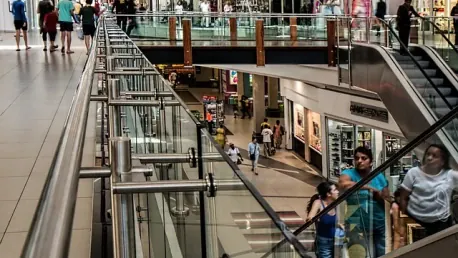The retail industry has been undergoing seismic changes, with longtime mall stalwarts struggling to stay afloat. Rue21’s recent announcement that it will close all 540 stores following its third Chapter 11 bankruptcy filing has raised alarms about the viability of mall-based retail operations. But is this a sign that the traditional brick-and-mortar mall experience is nearing its end? Let’s explore the factors driving Rue21’s downfall and what they mean for the future of mall-based retailers.
The Fall of Rue21: A Familiar Story
Rue21, founded in 1970 as Pennsylvania Fashions, has experienced a tumultuous history marked by rapid expansion and repeated financial distress. After rebranding in 2003 post-bankruptcy, the company seemed to be on an upward trajectory, even going public in 2009. However, the challenges facing Rue21 are symptomatic of broader issues within the retail sector. For Rue21, the COVID-19 pandemic accelerated existing problems. Lockdowns and social distancing measures drastically reduced foot traffic, exacerbating the shift to online shopping. As consumers increasingly preferred the convenience of e-commerce, Rue21’s reliance on brick-and-mortar stores became a significant liability. The company faced increased operational losses from underperforming stores and struggled to realign its business model with new consumer behaviors.
Additionally, Rue21’s growth strategy was heavily dependent on its mall presence. At its peak, the retailer operated close to 1,000 stores, primarily in strip malls, regional malls, and outlet centers. Unfortunately, this expansion strategy made Rue21 vulnerable to the declining trend in mall traffic, a factor that has plagued many traditional retailers. The emphasis on physical retail space, coupled with the inability to pivot effectively to digital platforms, left Rue21 in a precarious position. This scenario is emblematic of the broader struggles faced by mall-based retailers unable to adapt quickly to the fast-paced changes in consumer preferences and shopping habits.
Economic Pressures and Market Competition
Economic challenges have compounded Rue21’s struggles. The pandemic led to significant economic disruptions, causing a domino effect of challenges for retailers. Inflation and supply chain issues have also created a turbulent environment, making it difficult for companies with extensive physical retail footprints to maintain profitability. The costs associated with maintaining large store inventories and the inability to move products quickly enough contributed to Rue21’s mounting financial woes. Moreover, the heightened competition from both online and offline players has squeezed Rue21’s market share. Giants like Amazon and fast-fashion brands such as Zara and H&M have adapted more swiftly to the changing landscape. These competitors have effectively captured the target demographic, offering trendy clothing items faster and often at lower prices. The results have been devastating for traditional retailers like Rue21, which found it increasingly hard to compete.
In addition to the operational costs, the competitive pressure from more agile and tech-savvy retailers created an insurmountable challenge. Rue21’s management faced the daunting task of modernizing the brand while staying financially viable, a balancing act that proved impossible under the cumulative weight of economic pressures and market competition. Even the efforts to cut costs by closing underperforming stores and streamlining operations weren’t enough to stave off the financial drain. As consumer expectations shifted to favor speed, variety, and convenience—hallmarks of successful e-commerce models—Rue21’s traditional retail approach increasingly seemed outdated and unsustainable.
Attempts at Restructuring and the Path to Liquidation
Despite efforts to salvage the business, Rue21 couldn’t find a sustainable path forward. The company attempted to restructure its finances, seeking potential acquisition bids. Unfortunately, the returns from liquidation proved more favorable than continuing operations. Appointing Gordon Brothers of Boston to manage the store closures underscored that liquidation was Rue21’s best financial option. Rue21 isn’t the only casualty. The wave of retail bankruptcies paints a grim picture for the sector. Other notable retailers such as Rite Aid, Express, and 99 Cents Only Stores have similarly filed for Chapter 11, planning significant store closures. These events highlight a broader industry consolidation, forcing traditional retailers to reassess their business models seriously.
The decision to liquidate rather than attempt another turnaround or seek a buyer who might continue operations offers a sobering perspective on the current state of physical retail. It indicates that potential investors see more value in the company’s physical assets and brand names than in its ongoing operations. This trend is symptomatic of a larger market reevaluation, where the economic realities of maintaining vast brick-and-mortar networks are increasingly scrutinized. For many retailers, the path to profitability now lies in a hybrid model that marries online and offline experiences, a strategy that Rue21 was unfortunately unable to successfully implement in time.
The Shift to Online Shopping: An Irreversible Trend?
One of the most significant shifts in recent years has been the migration from physical stores to online shopping. The convenience, variety, and often lower prices offered by online retailers have transformed consumer habits permanently. For many, shopping online became the norm during the pandemic and is likely to continue even as restrictions ease. This shift raises questions about the future role of physical retail spaces. While some argue that experiential shopping—where the in-store experience itself is a draw—can keep malls and stores relevant, the financial burden of maintaining expansive physical locations remains an obstacle. Retailers now need to balance the offerings of a robust online presence with strategically located physical stores.
The ongoing success of e-commerce giants and the increasing foray of traditional retailers into digital platforms underscore the irreversible nature of this trend. Retailers that have successfully integrated online shopping with physical store experiences have not only survived but thrived, indicating a shift in the industry paradigm. However, this balance is difficult to achieve and requires significant investment in technology, supply chain logistics, and customer service, areas where many traditional retailers, including Rue21, have struggled. As the retail environment continues to evolve, the capacity to offer a seamless shopping experience across multiple channels will likely define the success and survival of retail brands.
Impact on Mall Retailing and Future Opportunities
The retail landscape is experiencing dramatic shifts, with long-established mall retailers finding it increasingly difficult to survive. Recent news that Rue21 will shutter all 540 stores after its third Chapter 11 bankruptcy filing has set off alarms about the future of mall-based retail. Does this development signal the demise of the traditional mall shopping experience? To understand this, we need to delve into the elements contributing to Rue21’s decline and what they imply for mall retailers moving forward.
A key factor behind Rue21’s struggles is the rise of e-commerce. As more consumers turn to online shopping for convenience and broader selections, foot traffic in malls has decreased, placing immense pressure on traditional retailers. Additionally, changing consumer preferences, especially among younger demographics, favor experiences over material goods, which brick-and-mortar stores often can’t match.
The high costs associated with maintaining physical stores, including leases, staffing, and utilities, exacerbate the problem. As a result, many retailers are reevaluating their strategies, with some shifting to a more online-focused model. While the conventional mall is not entirely obsolete yet, these trends suggest that brick-and-mortar retail must adapt or face obsolescence.








